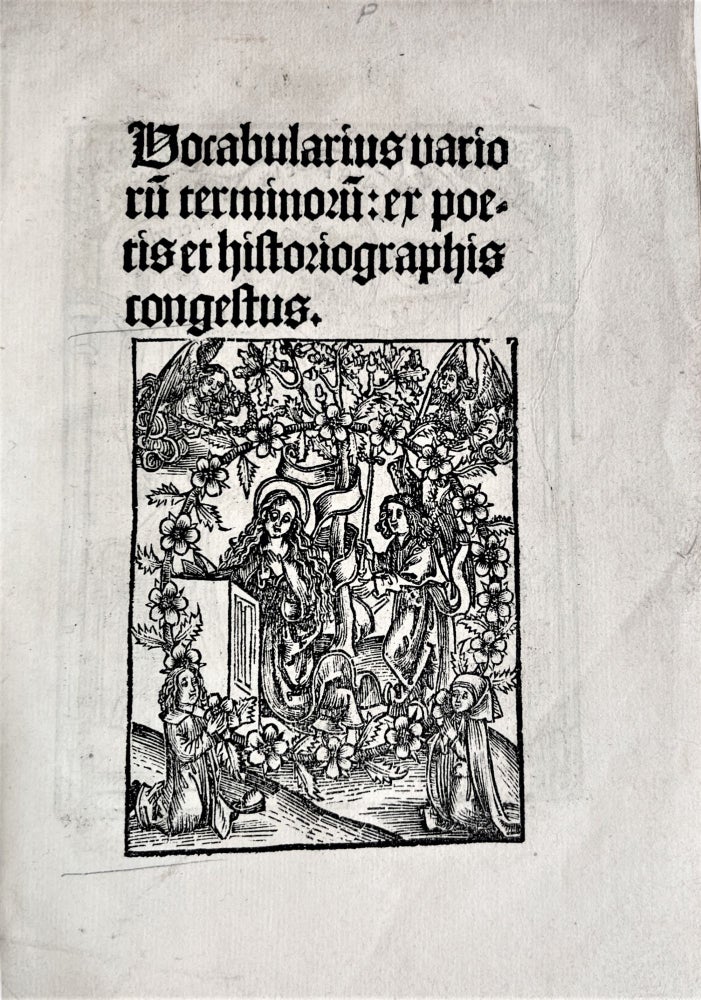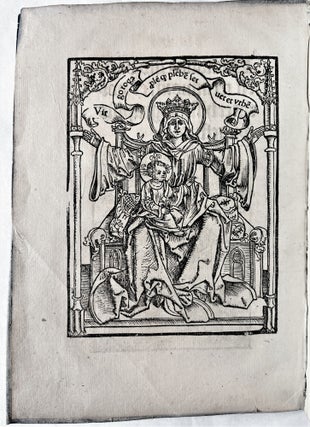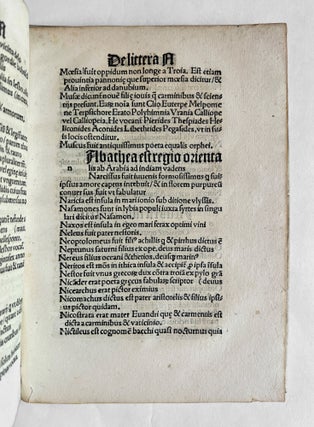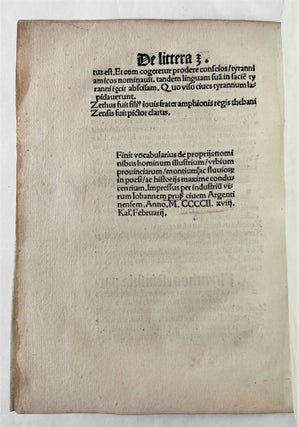Vocabularius variorum terminorum: ex poetis et historiographis congestus. Strassburg: Johann Prüss, 18 February [25 January] “MCCCCII” (i.e., 1502).
4to (200 x 142 mm). [34] leaves, the last blank. Title and headings in gothic type, text in roman. Initial spaces with guide letters. Annunciation woodcut on title: the Virgin and angel within a floral wreath, angels above and two worshippers below; on verso a full-page woodcut of the Virgin and Child in Majesty, with typographic inscription “Virgo roga pr[o]le[m] q[uod] plebe[m] seruet et urbe[m]” on an undulating banner. A nice copy (first and last leaves each with a short marginal tear to title-leaf, small stain to penultimate leaf, a couple of pencil underlines to colophon). Modern parchment over thin boards. ***
First edition, first issue, with the dating error in the colophon uncorrected, of a basic and still useful index of places and people in classical history, literature and mythology (mainly Greek). Written in simple Latin, this handy booklet, probably intended for students, provides concise identifications of “proper names of famous men [and women], cities, provinces, mountains, and rivers, most often found in poetry and histories.” The three-line introduction states that the glossary was condensed from Tortellius (from his massive Orthographia, first printed Rome 1471) and other unspecified works.
Indiscriminately intermingled by the alphabetical order are mythological and historical figures and places. Boiled down to basics, the usually one- or two-line definitions provided the busy student all he needed to know, with no sources or cumbersome notes (e.g., “Argonauts: the heroes who went to Colchos [sic] with Jason. Argo: the first great ship built in Thessaly for the expedition to Colchos...”). A few of the approximately 1200 entries require a bit more explanation: Socrates, for example, or the river Acheron, or Medea, or Ariadne (“Ariadne was the daughter of Minos king of Crete, who helped Theseus against the minotaur and who gave him her trust, which however did not protect her as he deserted her. Then Bacchus married her and Venus gave her a crown which is reported to have been raised among the stars” [the corona borealis].
The unrelated but attractive woodcuts are from Prüss’s stock. The fine woodcut of the Virgin and Child enthroned, with the motto “Virgin, call upon the child to serve the people and the city,” represents Strassburg; that image was used for the city’s seal. Prüss used the same cut a few weeks earlier (with a different setting of the type on the banner) for an edition of Filippo Beroaldo De tribus fratribus, Wimpheling’s Germania, and other short works (VD 16 B 2078). The woodcut has been tentatively ascribed to the young Hans Wechtlin (cf. Ritter).
I locate three US copies (Indiana State, first issue, U. Penn, and U. Illinois). Not in COPAC.
VD16 V 2018; Schmidt, Répertoire Bibliographique Strasbourgeois III Prüss, p. 10, no. 33; Muller, Bibliographie strasbourgeoise II: 14, 9; Ritter, Repertoire Bibliographique des Livres Imprimes en Alsace aux XVe et XVIe siècles 2439; BM/STC German 900; Proctor, Index to the Early Printed Books in the British Museum II 1501-1520 (1903), 9962. Item #4209
Price: $6,000.00




